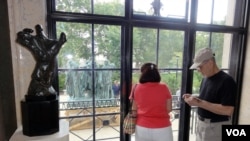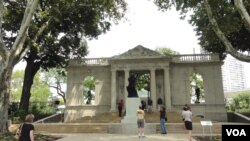Scaffolding still blocks the view of Auguste Rodin’s monumental "Gates of Hell" at the entrance to Philadelphia's Rodin Museum. And Rodin's famous sculpture of the "Burghers of Calais" has yet to be cleaned up.
But the museum has undergone a $9 million renovation and is once again open to the public.
Gail Stattler drove more two hours from Washington, D.C. to see the newly displayed works. “It was worth the trip," she said. "I think they did a great job.”
For the first time since the building opened in 1929, the Rodin Museum is arranged the way its architect, Paul Cret, and landscape designer, Jacques Greber, intended it.
That means that some of the larger sculptures, including the "Burghers of Calais," "Adam," "Eve," and "The Shade" have been returned to the garden, clearing the central indoor space for Henri Gréber’s replica of one of the French artist's most famous works, "The Kiss."
That replica was originally supposed to be the centerpiece of the museum’s main gallery. But in 1967, many of Rodin’s sculptures were moved inside to protect them from pollutants. After the move, "Burgers of Calais" became the new centerpiece.
“When we began to consider how to reinstall the galleries," says Museum Director Timothy Rub, "I wanted the sculptures that were placed by Cret in key positions in the exterior of the museum and in the garden to be once again outdoors.”
Advances in conservation have made that possible.
Philadelphia's Rodin Museum is home to more than 130 pieces by the artist, who died a century ago. It's the largest collection of his sculptures outside Paris.
Rodin's method of sculpting large pieces was to first make a small version from a material easier to handle than marble. Many of his large sculptures, including "The Thinker," were cast in bronze after his death.
Movie theater magnate Jules Mastbaum, who died in 1926, gifted the museum to the city of Philadelphia.
But the museum has undergone a $9 million renovation and is once again open to the public.
Gail Stattler drove more two hours from Washington, D.C. to see the newly displayed works. “It was worth the trip," she said. "I think they did a great job.”
For the first time since the building opened in 1929, the Rodin Museum is arranged the way its architect, Paul Cret, and landscape designer, Jacques Greber, intended it.
That means that some of the larger sculptures, including the "Burghers of Calais," "Adam," "Eve," and "The Shade" have been returned to the garden, clearing the central indoor space for Henri Gréber’s replica of one of the French artist's most famous works, "The Kiss."
That replica was originally supposed to be the centerpiece of the museum’s main gallery. But in 1967, many of Rodin’s sculptures were moved inside to protect them from pollutants. After the move, "Burgers of Calais" became the new centerpiece.
“When we began to consider how to reinstall the galleries," says Museum Director Timothy Rub, "I wanted the sculptures that were placed by Cret in key positions in the exterior of the museum and in the garden to be once again outdoors.”
Advances in conservation have made that possible.
Philadelphia's Rodin Museum is home to more than 130 pieces by the artist, who died a century ago. It's the largest collection of his sculptures outside Paris.
Rodin's method of sculpting large pieces was to first make a small version from a material easier to handle than marble. Many of his large sculptures, including "The Thinker," were cast in bronze after his death.
Movie theater magnate Jules Mastbaum, who died in 1926, gifted the museum to the city of Philadelphia.






